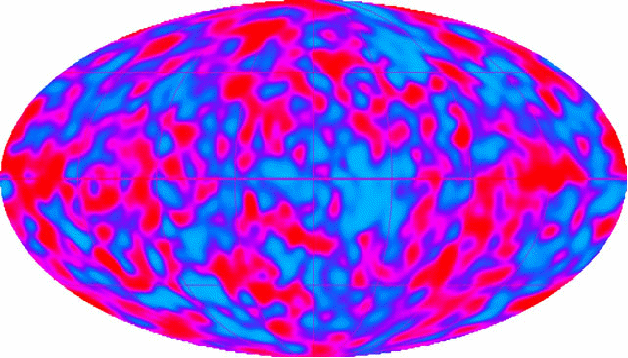In 1964, two young radioastronomers, Arno Penzias and Robert Wilson, accidentally discovered the cosmic microwave background radiation using a well-calibrated horn antenna. They thought it was due to instrument error, dirt etc. but it was soon determined that the radiation was diffuse, emanated uniformly from all directions in the sky, and had a temperature of approximately 3 Kelvin (2.73K). They initially thought their equipment was at fault, but it came to their attention that this background radiation had in fact been predicted years earlier (1948) by George Gamow, Ralph Alpher, & Robert Herman as a relic of the evolution of the early Universe.
The universe was once very hot and dense, a plasma, where all particles were dissociated. There was one unified force and matter was in equilibrium with radiation. As the universe expanded it cooled. There came a point when the unified force became four – or five, or more – forces, and radiation (photons) decoupled from matter. The radiation cooled further, and is now at 2.73 Kelvin.
The diagram below shows a representation of the universe where the angle represents the angle of view and the distance (radius) from the centre measures both distance and time since light travels at a finite speed.
The light coming from this cosmic photosphere (surface of last scattering) can be used to make an image of the early Universe. One can then learn about the Universe when it was a 1000 times smaller than the present. In 1967 Sachs and Wolfe determined that any observed temperature variations were directly related to variations in the density variations at that time.

A map of the sky at microwave frequencies, showing that the cosmic microwave background radiation is almost completely the same in all directions.
Given this qualification checked in limited regions by small angular scale observations, any attempt to interpret the origin of the cosmic microwave background radiation as due to present astrophysical phenomena (i.e. stars, radio galaxies, etc.) is discredited. Therefore, the only satisfactory explanation for the existence of the cosmic microwave background radiation lies in the physics of the early Universe.
While the cosmic microwave background radiation is predicted to be very smooth, the lack of features cannot be perfect. At some level one expects to see irregularities, or anisotropies, in the temperature of the radiation. These temperature fluctuations are the imprints of processes and features of the early universe. The COBE DMR instrument first detected these imprints and made them public in 1992.
